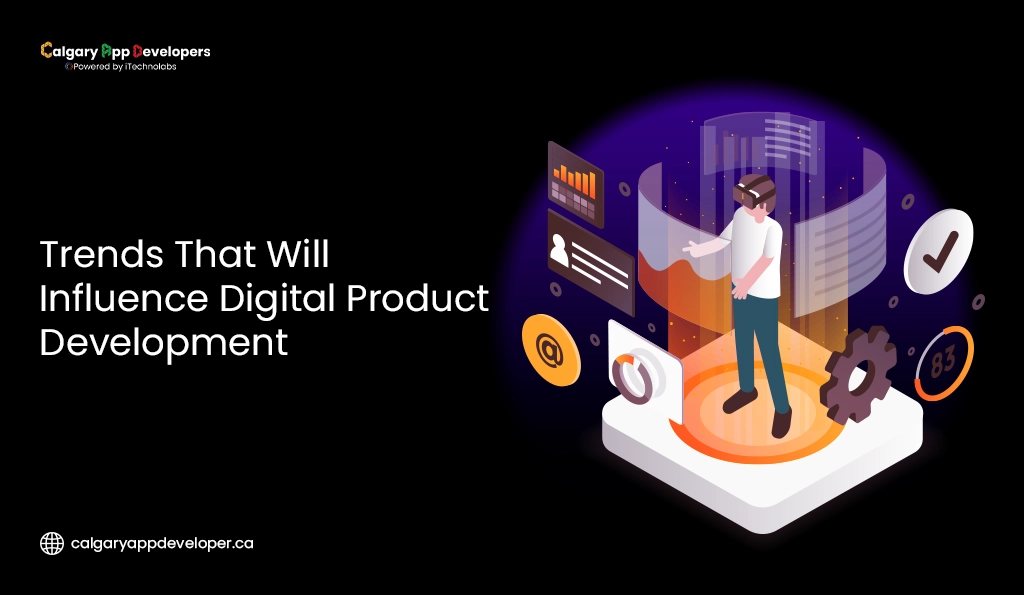10 Digital Product Development Trends for 2025 & Beyond

As we move deeper into the digital-first economy, the terrain of product development is changing at a speed and scale. New technologies, changing consumer patterns, and moving global dynamics are reconceiving how digital products are conceived, constructed, and grown. Whatever it is—a mobile app, SaaS platform, or rich virtual experience—digital products today need to be more than just work—they need to foretell user needs, evolve with change, and provide actual value.
In 2025 and beyond, companies will have to synchronize their growth strategies with major forces driving everything from user behavior to infrastructure at the backend. From the increasing prevalence of on-demand services and AI personalization to the cautious adoption of cryptocurrency and green tech practices, leading the pack requires knowledge of the drivers of the future of innovation.
In this blog, we examine 10 significant trends that are likely to inform the next wave of digital product creation—and how businesses can use them to remain competitive in a rapidly changing market.
Top 10 Trends Driving Digital Product Development in 2025
1. On-Demand Experiences Are Shaping User Expectations
Let’s face it—we’ve all gotten used to things showing up at our doorstep with a tap or two. From late-night food orders to instant doctor consultations, the demand for real-time everything has redefined user expectations.
By 2025, this hunger for instant availability won’t be limited to consumer apps. Whether it’s a B2B dashboard or a specialized wellness app, users desire smooth, fast experiences with minimal clicks or confusion.
For developers and product teams, this translates into frictionless design: instant updating, one-click, rapid-boot interfaces, and cloud backends scalable enough to service usage surges. It isn’t sufficient to make a product work—it must work in an instant and automatically.
The online on-demand home services market is expected to skyrocket from US $381 billion in 2024 to about $456 billion in 2025, with a jaw-dropping 19.7% CAGR through 2034
Take Gojek, the Indonesian super-app. What started as a simple bike-taxi service has evolved into a platform offering over 20 on-demand services, including food delivery, bill payments, logistics, and even wellness bookings—all under one app. Gojek’s ability to seamlessly combine multiple real-time services in one unified interface is a masterclass in building for instant gratification. It’s no surprise they’ve grown into one of Southeast Asia’s biggest digital platforms.
2. Modernizing Legacy Apps Is Becoming a Priority
As technology evolves, many businesses are held back by outdated legacy systems. These applications are often slow, hard to scale, and lack integration with modern tools—leading to productivity loss, security risks, and poor user experiences. In 2025, modernization is no longer optional; it’s a strategic necessity.
Modernization doesn’t always mean a full rebuild. It can involve cloud migration, adopting microservices, redesigning the UI, or adding features like automation and analytics to boost value.
For example:
- National Australia Bank (NAB) migrated its core banking apps from mainframes to cloud platforms, cutting costs and enabling faster feature rollouts through agile development.
- Logickx IT, a logistics software provider, transitioned its Oracle-based system to the cloud, first breaking up the monolith, then revamping the backend for improved performance and scalability.
Smart organizations are modernizing to stay competitive, secure, and ready for future innovation.
Also Read: Why Startups in the U.S. Are Hiring Fractional Dev Teams
3. Crypto Integration Is Rising — But So Is Regulatory Scrutiny
Crypto has moved well beyond speculative investing. We’re now seeing digital wallets, blockchain loyalty programs, and even decentralized apps (dApps) making their way into the mainstream.
If you’re in fintech, e-commerce, gaming, or logistics, integrating crypto solutions can open new doors. Faster cross-border payments, transparent transactions, and smart contracts are just a few ways blockchain is bringing real-world value.
And the market is responding. The crypto payment apps market is projected to grow from US $1.11 billion in 2025 to approximately $2.74 billion by 2030, signaling a robust 19.7% CAGR.
Meanwhile, the broader crypto-payment gateway space—which businesses plug into—is set to balloon from US $1.2 billion in 2023 to an estimated US $5.37 billion by 2032, growing at a steady 17.8% CAGR.
E-commerce giant Shopify is one of the most notable global players integrating crypto in a meaningful way. Through partnerships with Strike (using Bitcoin’s Lightning Network), Coinbase Commerce, and BitPay, Shopify merchants can accept cryptocurrencies like Bitcoin, Ethereum, and stablecoins—providing customers with faster, lower-fee alternatives to traditional payment gateways.
This move not only embraces decentralization but also positions Shopify as crypto-ready for a global customer base, especially in regions where traditional banking access is limited or costly.
But here’s the catch: this isn’t the Wild West anymore.
As adoption grows, so does regulatory scrutiny. Governments across the globe are rolling out stricter regulations related to data protection, taxation, Know Your Customer (KYC) compliance, and Anti-Money Laundering (AML). From the EU’s MiCA framework to India’s crypto tax rules and the U.S. SEC’s ongoing crackdowns, developers must design with legal soundness baked in.
4. The Metaverse Holds Promise — But Adoption Will Be Gradual
There’s no disputing the hype surrounding the metaverse. Everyone from technology giants to fashion brands has toyed with it. But will it reshape our everyday lives and workplaces in 2025? Not just yet.
Sure, there are hip applications—virtual real estate, 3D department stores, and experiential learning. But adoption remains sluggish because the hardware is pricey, platforms are fractured, and many users just aren’t yet prepared.
Automaker Hyundai created “Hyundai Mobility Adventure” on Roblox, allowing users (especially Gen Z) to interact with virtual versions of Hyundai’s future mobility solutions—like flying cars and EVs—inside a gamified metaverse space. The goal wasn’t just to sell cars; it was to create awareness and brand engagement through immersive storytelling. It’s a bold, long-view play in cultivating the next generation of customers—where they already hang out.
This kind of initiative shows that the metaverse doesn’t need to be all-or-nothing. You don’t need to rebuild your entire product in 3D—you just need to explore what’s possible. Whether it’s AR-powered previews, spatial audio chat, or interactive onboarding experiences, dipping your toes now can help you understand how your users might engage tomorrow.
5. AI-Powered Personalization Is the New Standard
Personalization once implied greeting customers by name. In 2025, that’s the minimum. With machine learning, digital offerings now know what consumers desire before they themselves do.
Whether it’s an e-commerce app making product suggestions based on browsing history or a meditation app varying tone according to user mood, AI is driving experiences that are intuitive and customized.
But AI isn’t all about slick algorithms. It needs clean, germane data, real-time feedback cycles, and considerate UX design. And don’t forget—transparency and permission are important. Just because we can forecast behavior doesn’t necessarily mean we should do it in a user-reactionary vacuum.
The AI-based personalization engines market was worth US $455 billion in 2024, and is expected to reach $474 billion in 2025, with plans to grow to $718 billion by 2033 (CAGR 5.3%).
Stock trading platform Robinhood has leaned heavily into AI to enhance user experience. Its algorithms personalize everything from stock suggestions and investment news to educational prompts based on trading habits. For example, if a user frequently trades tech stocks, the app might suggest relevant ETFs or notify them of sector-specific news. Meanwhile, beginners might get nudges toward educational content rather than high-volatility picks—creating a tailored experience that adapts as the user grows.
6. Data Privacy and Digital Trust Are Front and Center
In a data-rich experience world, users are becoming more aware—and wary—of how their data is collected, stored and used. Data privacy will be just as important in 2025 as it has been with the biggest breach headlines of 2022 and ever-increasing regulations in other countries like India’s DPDP Act and across virtually every segment in the world from GDPR (General Data Protection Regulation) in Europe, previously in online banking and healthcare solutions.
Not only are they privy to regulations, but also important decisions surrounding the data collected, managed, and used, or not used, that lead businesses to rethink how they collect data, as well as think about how to limit overreach along with their data practices, and use a privacy-by-design approach in embedding more ethical practices within their product.
This means that companies and developers must shift their mindsets to prioritize secure architecture choices, encrypt data, anonymize, utilize and be up-front about their ethical data use practices and policies while creating clear privacy policies, opt-in mechanisms, and user dashboards to manage their data choices. This is no longer a takeover or policy—this is a demand!
Building trust no longer lives simply in product capability. This is now about demonstrating that you manage and handle a user’s personal data and private information ethically. There is also competition; brands seeking to invest anyone’s digital trust, or safeguard digital trust in user experiences, not only ensure regulatory compliance but also rely on it and use data privacy as a competitive advantage in the market!
Read Also: Top Mobile App Development Platforms
7. No-Code and Low-Code Platforms Are Accelerating Development
Let’s cut the fluff—not every app idea needs months of dev time. In 2025, no-code and low-code tools aren’t dabbling side projects—they’re fast lanes to getting stuff done.
Need a quick customer portal? A no-code builder lets you launch in days, not weeks. Automating internal processes? Low-code platforms can put systems in place by tomorrow morning, freeing dev teams to focus on the real heavy lifting.
These platforms aren’t silver bullets. If you’re building performance-intensive or highly customized systems, full-stack code is still king. But when you’re prototyping, launching MVPs, or building internal tools, they are incredibly effective. They let designers, project managers—even marketing folks—actually shape the product instead of just describing it.
The low-code platform market is estimated at US $21.2 billion in 2025, growing to nearly $81.4 billion by 2030—that’s a massive 30.9% CAGR.
Together, the no-code + low-code market is expected to increase from US $40.7 billion in 2025 to an astonishing $256.5 billion by 2033—a 25.9% annual growth rate.
No-code and low-code are no longer experimental sidekicks. They are essential tools for staying agile, responsive, and efficient in today’s fast-paced product world. Build fast, learn fast, and use your core dev muscle where it counts most.
8. Cross-Platform Development Is Becoming Essential
Let’s be clear: your users don’t care whether you built your product with Flutter, React Native, or native SDKs. They just want it to work seamlessly—on phone, tablet, desktop, or whatever device they’re using.
Imagine this use case: a user starts a task on their phone during their commute, revisits it on a tablet during lunch, and finishes it on a desktop that evening. If any of those experiences stutter, feel off, or behave differently, you’ve lost their trust (and possibly their business).
That’s where cross-platform tooling comes in. Frameworks like Flutter, React Native, and Xamarin let you write once and deploy anywhere, trimming down development time, avoiding duplicated effort, and maintaining a single codebase with consistent UI and logic.
Of course, “one codebase” doesn’t mean “no tweaks.” You’ll still need to manage performance, tailor the UI for different screen sizes, and handle platform-specific quirks—like Android back buttons or iOS gestures. But overall, you’re investing smartly in speed, cohesion, and ease of maintenance.
The global cross-platform software market surged from US $90.1 billion in 2024 to an estimated $104.6 billion in 2025, growing at 16.1% CAGR—and it’s projected to reach a whopping $187.6 billion by 2029.
Take Unilever, one of the world’s largest consumer goods companies. They’ve used SAP’s AppGyver—a leading no-code platform—to rapidly build internal tools and dashboards across departments. Instead of waiting for developer cycles, business teams at Unilever can now create lightweight apps to streamline workflows, improve efficiency, and respond to operational needs in real-time. This isn’t a startup hack—it’s enterprise-grade adoption of no-code, and it’s helping a massive global company move faster without overloading IT.
Cross-platform development isn’t the future—it’s now. With platforms growing fast (and projected to double or triple in value), ignoring them means extra development hassle and fragmented products. For digital products that span devices, cross-platform frameworks are essential tools in your toolbox.
9. Outsourcing Development for Flexibility and Scale
Outsourcing is no longer the cheap option it was once considered to be. It is now a strategic option that allows a business to grow fast and gain access to world-class talent.
And guess what? Canada—home to many top-tier dev shops—has become a global outsourcing powerhouse. The Canadian IT outsourcing market is forecast to reach US $12.93 billion in revenue by 2025, growing around 8.2% CAGR to hit about $17.7 billion by 2029.
Canada, specifically, has become a hotbed for global development. Some of the most skilled digital squads in the world call Toronto, Vancouver, and Calgary home. Need trusted, high-quality work that fits with your culture? Calgary app developers are becoming a leading choice for businesses in North America and beyond.
A great showcase of smart outsourcing is ELD, a mobile platform built to inspire health, social connection, and community-driven experiences. The app lets users host and join activities—from fitness competitions to art workshops—while offering integrated chat and group features to foster authentic interaction.
Rather than hiring a large in-house tech team, ELD collaborated with Calgary-based app developers to bring the platform to life. The result? A polished, scalable product with features that support real-time updates, secure communication, and smooth user experiences—all without draining their internal resources.
Also Read: Top App Development Companies in Canada
10. Sustainability in Tech Is Driving Product Innovation
With climate awareness on the rise and more environmental regulations being enacted, sustainability is fast becoming more than a footnote; it’s a major part of digital product strategy. By 2025, users, investors, and stakeholders will increasingly prefer products that not only work well but also reflect ecologically conscious values.
This change is influencing everything from design decisions to decisions on infrastructure. Developers are also optimizing code for energy efficiency and reducing server loads by using green cloud computing. User interfaces are also designed to reduce unnecessary actions or sharing data to help reduce the overall carbon footprint of digital products.
On the macro level, sustainable development practices that are also included in development projects are designing for long-term maintainability, designing for modular architecture to reduce wasteful rebuilds, and applying responsible data storage policies. In the end, businesses are not only helping the planet, but they are also future-proofing products and improving brand image.
Furthermore, sustainability is becoming a differentiator. In the future, when products become increasingly more similar, the means by which a product hurt the planet will inform a customer’s purchase decision. Progressive-thinking organizations are working sustainability into their innovation process, creating digital solutions that are productive and responsible.
Final Thoughts:
The future of digital product development in 2025 is being shaped by technology, consumer behavior and an increasing focus on ethics, scalability and innovation. The move toward on-demand apps and delivery services, along with growing application of AI to enhance personalization for online customers, is showing a wider trend toward stronger, smarter, faster and more responsible digital products and services. The arrival of the metaverse and growing organizational significance of sustainability are likely to reinforce this trend further.
Whether you are a developer or a business, staying current with innovation is more than embracing new technology products and tools; it requires systematic thinking, human-centered design and the capacity to shift new strategies and adapt with the market and user requirements. Every organization is now more aware of needing to shift and adapt with digital transformation in order to retain or increase their market lead, whether it’s going through the modernization of a legacy application or having an app developed by an agency that specializes in such, like Calgary’s initial access to the quickest app developers.

Pankaj Arora
Founder, Calgary App Developers
Pankaj Arora is a seasoned technology leader and the Founder of Calgary App Developers, with 7+ years of expertise in crafting high-performance digital solutions. His core competencies include full-stack app development, cloud-native architecture, API integration, and agile product delivery. Under his leadership, Calgary App Developers has empowered startups and enterprises alike with scalable mobile applications, secure web platforms, and AI-driven SaaS products.






